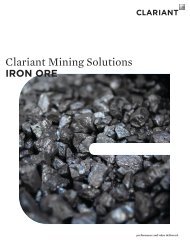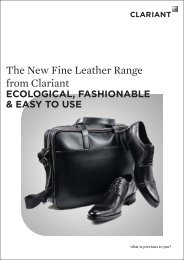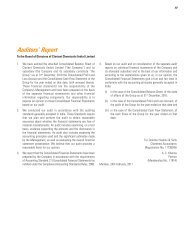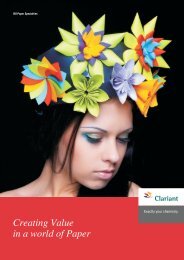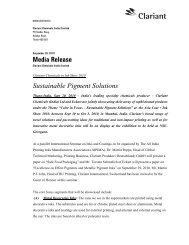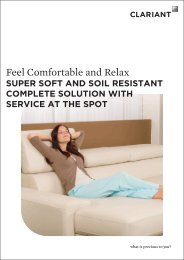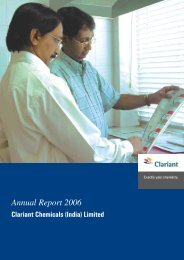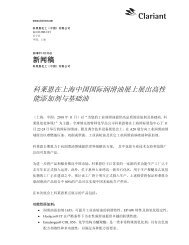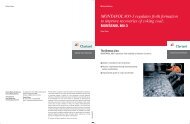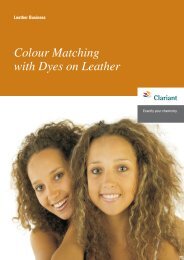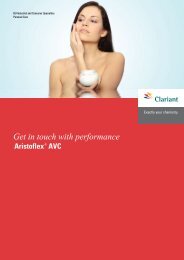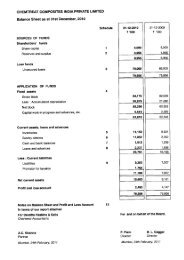Create successful ePaper yourself
Turn your PDF publications into a flip-book with our unique Google optimized e-Paper software.
6<br />
textile<br />
Alkali-scheme<br />
Fixation formula Suitable Drimaren<br />
Soda – formula K – HF<br />
NaOH + Silicate K – HF and CL<br />
NaOH + Soda K – HF and CL<br />
Soda formula<br />
Soda formula has long bath stability even<br />
at temperature upto 30 – 35°C.<br />
Are mostly used for heavy material due<br />
to long fi xation (better penetration).<br />
Give the impression of better<br />
levelness.<br />
Easy wash-off, no silicate.<br />
NaOH + Silicate<br />
NaOH + Silicate, in some cases, has even<br />
longer bath stability than soda-formula and<br />
are also stable at higher temperature of 30<br />
– 35°C.<br />
Fixation time around half of the sodaformula.<br />
The wash-off has to be very well<br />
monitored, beginning with cold water,<br />
to remove the silicate.<br />
<strong>colour</strong> <strong>chronicle</strong> 1 | 2009<br />
Dyeing on PES/PAN Fibers<br />
Dyeing on PES/PAN depends on the material<br />
but we can try to give you a general process<br />
for this blend on knit goods by exhaustion.<br />
There are three kinds of process.<br />
1. Two Bath Process with Carrier at 108°C<br />
This method is appropriate;<br />
if HT equipment is not available or if the<br />
dyebath cannot be brought to the boil,<br />
as a result there is no assurance of<br />
satisfactory shade buildup, particularly with<br />
dark shades such as black and navy.<br />
in the case of deep dyeings since the<br />
exhaustion of the cationic dye from the bath<br />
is retarded by the large amounts of carrier<br />
(retarding effect).<br />
Pre-dyeing the PES component has the advantage<br />
that the coloration of the PAC component by the<br />
Foron dye can be controlled.<br />
1st bath: Dyeing the PES component<br />
Dyebath additions<br />
2 – 6 ml/l Dilatin POE liquid<br />
2 g/l ammonium sulphate<br />
pH – 5 using formic acid<br />
CL and HF dyes requires less silicate<br />
than normal Vinyl Sulphone dyes and<br />
about half the amount of silicate.<br />
NaOH + Soda<br />
NaOH + Soda has shortest bath stability<br />
and highest exhaustion of the bath due to<br />
substantivity of the individual dyestuff.<br />
This alkali – formula is very sensitive<br />
to temperature. Should only be used<br />
at a constant temperature of around<br />
20 – 25°C.<br />
Fixation time is the shortest.<br />
Easy wash-off.<br />
Tailing<br />
Is caused by hydrolysis and difference<br />
in substantivity of the dyes.<br />
During hydrolysis the dye gets unstable<br />
and is reacting with the – OH group.<br />
Can only be controlled by alkali-scheme,<br />
temperature and time of the bath turnover.<br />
Substantivity is property of the selected<br />
dyes, individually.<br />
Dyeing Programme<br />
2nd bath: Dyeing the PAC component<br />
Dyebath additions.<br />
0.5 g/l sodium acetate<br />
pH 4.5 using acetic acid<br />
0.5 – 2% Retargal ANI liquid<br />
0.1 – 0.5 ml/l Ekaline FI liquid<br />
Dyeing programme<br />
Pad-Batch with Drimaren Parameters for Perfect Dyeing<br />
Dye selection.<br />
Alkali – formula.<br />
Temperature constant at 25°C (CDG<br />
has an advantage, dyestuff tank does not<br />
have to be cooled down and no urea).<br />
Dosing pumps; 1 : 4 alkali / dye. Most<br />
dye manufacturers have made their<br />
recipes after this dosing system.<br />
Pick-up 75 – 85 %, woven material,<br />
110 – 120 %, knitwear.<br />
Bath content 20-30 litre.<br />
From going into the dyebath until the<br />
padding mangle at no more than 1.5<br />
sec, else higher risk for exhaustion of<br />
the bath. Always use a wetting agent,<br />
like Hostapal UH. CN liq.<br />
The dye bath should only contain one<br />
roller at the bottom. With more rollers<br />
on top of each other, the pick-up cannot<br />
be controlled from side to side.<br />
Speed should not extend more than<br />
50 m/min.<br />
The batching temperature has to be<br />
constant at 30°C.



